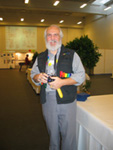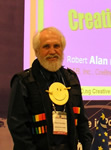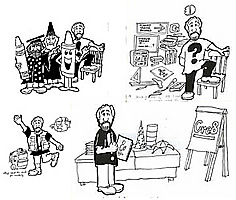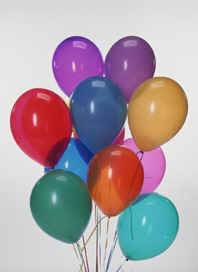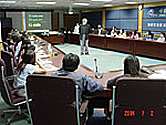..Cre8ng ..People, Places & Possibilities!
Developing the Creative Thinking & Idea Generating Skills of ALL Your Employees
Books & Materials ..........*FREE articles... ... Services Speaking-Consulting-Training
... Promotional Materials Extra Fun Stuff Wandering Alan's Global Travel
|
Create with Alan & CP3
click for information about
Creative Idea Generation & Creative Solution Finding & Generation
Creative Thinking Facilitation
Creative Thinking & Problem Solving Training
for yourself, your team/staff/organization
alan@cre8ng.com cre8ng@mac.com
Learn to be MORE Creative NOW! Here are some beginning exercises and 4 Lessons to strengthen and reawaken your creativeness and creative thinking skills If you are interested in more, perhaps the other 48 of the first 52 contact me at... alan@cre8ng.com cre8ng@mac.com
To help you become more creative is the purpose of this section of my growing website. Let's get started! Think of 6 new uses for a brick/a paper clip/an audio cassette tape box.
Then the next step after you have increased your FLUENCY of ideas, From there we will continue to work on 52 separate creative thinking traits that you can continually develop for as long as you live. After awhile you will discover that usually generating ideas is the easy part. As you continue through this basic course I will show you a series of creative thinking tools from the rational, to the intuitive, to the group focused to the systematic. Some will come easy. Others may be hard work.
alan@cre8ng.com cre8ng@mac.com
Our capacity to be creative can be awakened and expanded at any time. The key for you is that you CHOOSE TO BE CREATIVE and you can choose to be any day of your life. Some days may be more difficult yet you still can still be deliberately more creative even on tough, frustrating, depressing days. Now lets try again with your creativeness. Generate a list of 12 completely different potential uses for glass marbles that kids play with. None of the ideas can be what they are normally used for.
Creative Thinking Tool #01 - Change your perspective.
Did you get stuck with the marbles exercise? Okay here is a quick way to expand your number of "different" types of ideas. Imagine that you are different people and try to think like them: Make a list using the alphabet of different kinds of people or occupations. Then imagine you are each one of these individually and try to think of ideas they might generate. Try this and see if you can generate 12 to 24 more ideas for additional, new, unique uses for marbles. alan@cre8ng.com cre8ng@mac.com
He discovered that they all possessed and capitalized on the 4 same traits: fluency...they generated many ideas for every challenge or problem Lesson Two is focused on ELABORATION. Pick up 3 to 6 objects in the room you are currently in. Imagine the history of each of them from when they were conceived, designed, made and their lives since. Think in explicit detail. Have fun with the exercise. Add humor. Deliberately be funny, even silly. Give them human names, personalities. Create their families, their friends, their enemies. The more you see, hear, smell, taste, touch, feel (emotionally), intuit about a challenge the more creative your thinking will become. Do this once a week until it becomes a habit. Invite your spouse, children, friends to play ELABORATION games. It will be great practice and the results will be your Elaboration and creative thinking skills in general will become stronger and stronger. alan@cre8ng.com
Lesson Three: Deliberately Be Original To be more original more often ask yourself the following types of questions. 1. what has this never been used for or What might it be used for? or Use Bob Eberle's famous S.CA.M.P.E.R. series of questions devised from Alex Osborn's (creator of Brainstorming) original 83 thought provoking questions. Bob was the first creativity consultant I met (1976) and he introduced me to CPSI in Buffalo. S. SUBSTITUTE So practice by picking an object you can see or think of one and generate 12 to 144 original ideas. With each idea strive to be even more original. Substitute...what materials might be substituted for the original material Combine...what can we combine "X" with to do something else? Adapt...how might we adapt "X" to do something else or look different? Minify/Magnify...what might we use "X" for it Put to other uses... Eliminate something about it? Reverse how it is used currently? To see a list of 83 random ideas for paperclips click on PAPERCLIPS alan@cre8ng.com cre8ng@mac.com
So Lesson 4 is for you to spend 30 to 60 minutes each day for a week being deliberately curious about different things or subjects each day, i.e.: MONDAY be curious about new novels
You might want to begin developing a CURIOSITY journal, folder, file, box of stuff that you can continually add notes, clippings or things to. REMINDER.... THE MORE CREATIVE YOU CONTINUE TO BE alan@cre8ng.com cre8ng@mac.com
|

